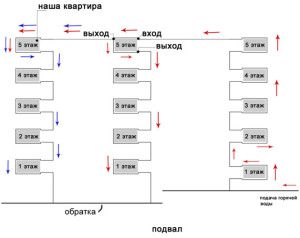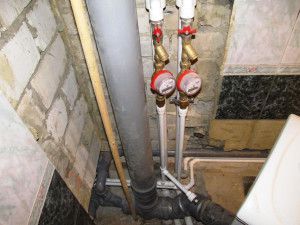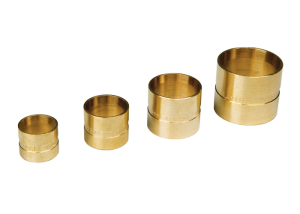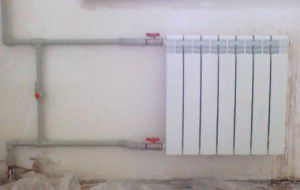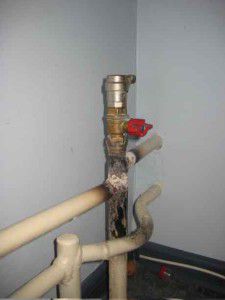The distribution of coolant in multi-storey buildings is carried out using vertical pipes. They pass through all floors of the house, and radiators and batteries are connected to them. Therefore, it is necessary to consider the characteristic features that heating pipes have: shutdown, replacement, thermal insulation.
Purpose of heating pipes
Piping with risers is an outdated scheme. However, given the large number of old-style buildings, it is rather laborious and expensive to make modernization of heating for them. Most often it is necessary to replace the heating risers in an apartment building with more modern ones made of polymer materials or install additional thermal insulation and make repairs.
The performance of this heating element depends on the geometric dimensions and the material of manufacture. The main diameter of the heating pipe must be equal to the same size of the connected pipes. Otherwise, a pressure drop will occur, due to which the heat balance throughout the house will change, the noise level will increase.
In order for the replacement of the heating riser in the apartment to be as professional as possible - you need to know its main functional purposes:
- Coolant distribution by consumers. At the entrance of each apartment building can be from 4 to 8 risers. In some cases, in one apartment their number reaches 4;
- Depending on the heat supply scheme, the riser may hot coolant delivery functions and at the same time transportation of cooled. This is typical for a single pipe system. In a two-pipe, at least 2 such elements are necessary;
- Hydraulic load balancing. Despite the inevitable bending of the heating pipe, it must still evenly distribute the pressure over its entire height.
But the consumer is more concerned with the issues of the domestic plan than the operational one. How to turn off the heating pipe and what needs to be done for this? This question arises with the possible replacement or repair of batteries, radiators and heat pipes in the apartment. To solve this problem, you first need to decide on the adaptation of new components to an already installed heating riser.
You can not connect a warm water floor to the central heating through the riser. This will unbalance the entire system.
Installation of a heating riser
The transfer of the heating pipe or its replacement is a complex procedure in terms of laboriousness and design. It is best not to carry out these activities during the heating season when the system is not functioning. But this is not always possible.
To replace the heating riser in the apartment, you will need to solve two issues:
- Get permission.
- Correctly select the components and installation scheme for the new vertical pipeline.
Only then can the heating riser be changed. In winter, this issue needs to be agreed not only with the management company, but also with the residents of the house, through whose apartments there is a riser.
The circulation pump must not be mounted on a heating pipe. This will lead to a change in water pressure and, as a consequence, to a violation of the thermal regime of the heat supply of the house.
How to disconnect the riser from heating
Legal shutdown of the heating pipe during the heating season is a big problem when repairing or installing new radiator pipes. The difficulty lies in the fact that the coolant flow completely stops in this circuit.
A similar procedure is necessary when repairing and installing new components of the heat supply system. Turning off the heating risers in winter is not done right away. To do this, you must write a statement to the management company, agree on a date and time. Otherwise, the following problems are possible if you block the riser without these steps:
- Lack of heat supply throughout the heating circuit will lead to lower temperatures in the apartments of other residents.
- Non-compliance with the normalized degree of heating of air in residential premises will completely fall on the person who arbitrarily disconnected the riser. When filing a claim, he will have to pay moral and material compensation;
- When the heating pipe is turned off during the heating season, for the installation of new components without permits, it is possible to temporarily shut off the heat supply in the apartment by representatives of the management company.
How to properly turn off the heating risers in winter? Firstly, it is necessary to indicate the reason for initiating this action together with the application. It may consist in replacing already installed heating components with new ones, but with the same parameters. To block the heating riser in connection with the modernization of the system, you must perform the following actions:
- Obtain Technical Conditions (TU) from the management company. This document indicates the technical parameters of the new components, as well as the piping layout.
- After completing the technical specifications, all the necessary components are purchased, including for replacing the heating pipe.
- The time for shutting down the heat supply is agreed. Installation can be carried out both by the residents of the apartment, as well as by hired workers. After checking the representatives of the management company, the heating system starts again.
Often, for a new circuit, it is necessary to transfer the heating pipe. In practice, this procedure will be extremely problematic. In contrast to turning off the heating riser during the heating season, in addition to permission from residents and the UK, re-planning of the heat supply in all apartments on this circuit will be required. It will not be possible to do this, since for this it is necessary that in each apartment not only the heating stand be turned off in winter, but also the configuration and arrangement of the heating devices will be changed.
If the time for closing the heating riser is small, you can arrange with a local plumber. He will do this without too much red tape for a moderate fee.
Rules for installing a new heating riser
Before you turn off the heating riser for installing a new design or replacing the batteries, you should find out the rules and recommendations for its installation. They are described in detail in SNiP 3.05.01-85.
Each heating riser in an apartment building was installed in accordance with these standards. Therefore, it must be replaced with a similar design with the same technical and operational parameters:
- The inner diameter of the pipe should not differ from the previously installed;
- The maximum possible bend of the heating riser cannot exceed 2 mm per 1 m. its length;
- For pipes to pass through floors, it is necessary to install special sleeves. They should be flush with the ceiling and be 30 mm higher than the finishing floor.
So when replacing the heating riser in the apartment, you must observe the minimum distance from its outer surface to the wall. If this condition is not met, additional heat losses are possible, since the structure is most often located near the outer wall of the building. This distance directly depends on the diameter of the heating pipe.
| Diameter of the riser, mm | The minimum distance to the wall, mm |
| 32 | 35-55 |
| 40-50 | 50-60 |
| More than 50 | According to the working documentation |
If there is a partial replacement of the heating pipe in one apartment, the pipe ends must go to the neighboring rooms located above and below. Otherwise, the conditions of SNiP 3.05.01-84 will not be met, which will cause the representatives of the management company to reject the project.
When installing the bend of the heating riser, it is forbidden to make pipe connections, which after installation will be in the floor.
The choice of material for manufacturing the heating riser
In the vast majority of cases, the heating pipes in an apartment building are made of steel pipes. After several decades of operation, their condition will be unsatisfactory. If the apartment is replacing pipes with new ones, you must also install a riser made of quality materials.
However, difficulties may arise. The technical characteristics of the new material for the manufacture of pipes must meet the requirements. You can learn about them from the technical conditions from the management company, or by consulting their representatives by phone. Most often they are as follows:
- Correspondence of pipes to the temperature regime of heating. Those. the new design must withstand the maximum possible thermal effect without emergency situations;
- System pressure. For centralized heating, it can be from 3 to 6 atm. But you need to remember that periodically hydraulic shocks may occur (when filling the system). Therefore, a margin of 25-30% must be added to the normalized pressure value. That is why it is impossible to install the circulation pump on the heating riser;
- Ensuring proper pipe insulation. This should only be done if it passes through a non-residential building where exposure to freezing temperatures is possible. For this, thermal insulation of the risers is made.
Several classes of pipe manufacturing materials meet these requirements. The easiest way to install the same steel. But most often the choice is stopped on polypropylene models.
To equip the heating riser, it is best to choose a polypropylene pipe of high strength class - PN25. It is designed for high maximum pressure. The problem may be in the temperature mode of heating. If the upper limit exceeds the value of + 90 ° C - installation of polypropylene is not possible. Then the only option is steel pipes.
In no case can you mount metal-plastic lines. Despite the good thermal insulation performance, the risers of them will be extremely unreliable. This is due to periodic pressure drops in the system. Gaps most often occur in the connecting nodes, which are made of clamping fittings.
After turning off the heating riser, before its first start-up, it is necessary to make its crimping. Only then can the coolant be fed into the circuit.
Rules for connecting radiators to the riser
Replacing the riser is most often associated with a general modernization of the heating system. At the same time, not only new pipes are installed, but also radiators and batteries. It is important to choose the right scheme for their connection with the heating system.
First you need to equip the radiator so that it can effectively perform its functions. Its binding should include the following components:
- Stop valves. With it, you can completely limit the flow of coolant into the battery for repair or replacement;
- Temperature controller. It is necessary to reduce heat flow in order to reduce surface temperature;
- Mayevsky crane. A device for removing air jams.
In addition to the possible insulation of the heating risers, the layout of the supply lines is taken into account. For a single-pipe system, a bypass is mandatory. This is a pipe segment connecting the inlet and outlet pipes of the radiator. The diameter of the bypass must be one size smaller than that of the riser. In this case, the occurrence of a zone of reduced pressure in the system can be avoided.
Experts recommend using the same pipes to connect the drain to the battery. This is necessary to normalize the operation parameters of the entire system, in addition, greatly facilitate the complexity of installation. As an additional measure, pressure and temperature sensors can be installed. Thus, the quality of the heat supply service can be controlled.
To prevent premature battery blockage, a strainer is recommended. It is mounted on the supply pipe in front of the thermostat.
Neighbors blocked the heating riser - what to do?
Despite the fact that heating repair is best done outside the heating season - some do not adhere to this rule. What to do if the neighbors have blocked the heating pipe and one of the heating circuits is not functioning?
There are many recommendations to address this issue - from general censure to calling the police. In the end, this will lead to the desired result - the air temperature in the rooms will be normal. However, such methods are not correct. If there are suspicions that the neighbors blocked the heating riser, you need to perform the following actions:
- Call the Management Company and make sure that no repair or maintenance work is currently underway in the house.
- No need to run around the apartments and look for the reason for the trip. Representatives of the management company should be called to resolve this issue. It was with her that a contract was signed for the supply of heat to the apartment.
- After the culprit was found - he can be threatened with a fine for unbalancing the heating system. This item is mandatory in the heat supply agreement.
Only such methods can achieve the resumption of heating. All others require too much unnecessary effort, and also lead to loss of time and nerve cells. Everyone must fulfill their contractual obligations. This primarily concerns the management company.
In the video you can familiarize yourself with the features of replacing the heating riser:
